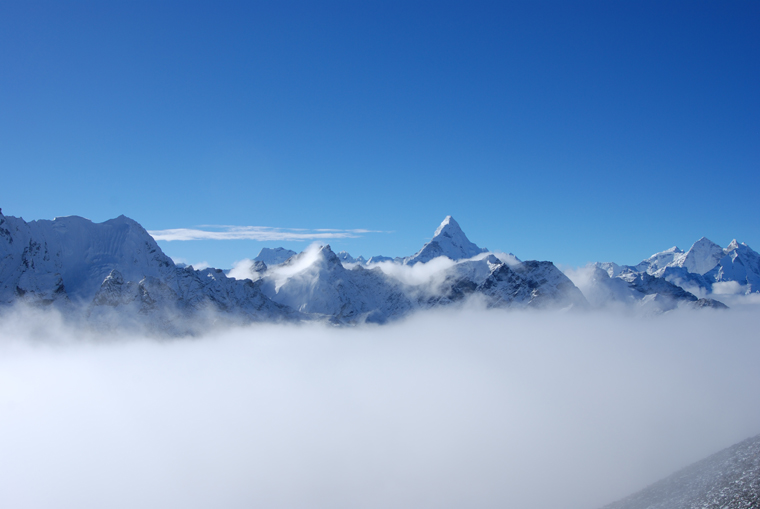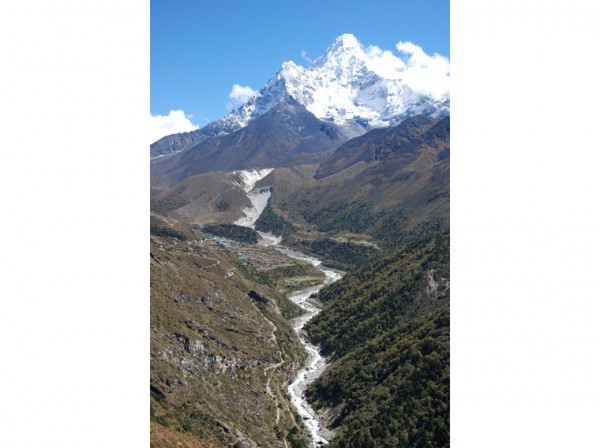Conquering a personal Everest
The Toronto Star | Saturday, March 5th, 2011

By Cindy Fan
KHUMBU, NEPAL—It could all be for nothing, I think darkly. You could reach the summit of Kala Patthar, it could still be cloudy and you won’t be able to see a thing.
I’ve been promised that the view of the Himalayas atop Kala Patthar, an oxygen starved 5,545-metre high, is worth the effort of waking at 4:30 a.m. and pushing myself, with every ounce of strength, to take one step after another up the side of the mountain. It is what I have had to do for the last nine days to get here, and at the final test my will to keep going is failing.
An hour ago I had been burrowed deep in my sleeping bag in a tea house in Gorak Shep, a trekker’s last outpost before Nepal’s Everest Base Camp. Now, hiking in this bleak greyness, all I can think of is how desperately I want to go back to sleep and finish my dream. I had been dreaming about chicken schnitzel and beer.
Seriously.
Vivid dreams are one of the more curious side affects of high altitude. And if you had been trekking in the Himalayas subsisting on lentils and rice for days, you too would be having wanton desires for breaded, fried meat cutlets.
With only tea in my grumbling stomach, my guide Dawa and I set out in the dark to begin the two and a half hour hike up.
It doesn’t feel like I’ve woken. Enveloped by the fog I cannot see how far I’ve come, how far I still have to go to reach the top. I feel lost in this strange state of in-between. I can only march on and up the switchbacks of frozen mud and snow. At an elevation of 5,545 metres, there is 50 per cent less oxygen. Think positively, I tell myself.
On the plus side, you have 50 per cent more oxygen than you would have if you were dead.
How’s that?
I stop to “catch” my breath. The figure of speech is appropriate since the futility of trying to catch your breath at high altitude is akin to trying to physically grab the air with your hand. I lean against my trekking pole panting. I look up at Dawa waiting patiently.
He doubts you can do it . . .
No he’s not. Be quiet. He knows I can do it. I know I can do it.
What does it feel like?
It feels like the last kilometre of a 10-hour bike ride and I have a plastic bag over my head.
How in the world did I get here?
I can trace every step of this trek which began with a one hour flight on a dodgy 12-seater prop plane from Kathmandu to Lukla airport, landing on one of the steepest and scariest runways in the world (it’s perched on a cliff). It has been a difficult daily slog ever since: hiking up over passes, down to cross a river, a spirit-breaking climb back up higher, ever so much higher, little lowland lungs clamouring for oxygen, exhausted body crying for a break.
But how did you get here? the pesky inner voice repeats.
Is this an existential question? Haven’t I had enough of that already? It is impossible to walk amongst these mountains—mountains of an unimaginable scale—and not question the nature of being. Nothing could have prepared me for the sight of these snow-capped peaks, the gleaming indomitable fortress rising into high heaven; I am but a speck. To stand before them and to behold them is to experience what philosophers call the sublime.
But there is a cruel beauty to the Himalayas. It can elevate the soul while bringing you to your knees physically, psychologically.
“Jum-jum,” Dawa says, Nepali for “let’s go.” It’s the encouraging nudge I’ve received throughout the trek. I groan and make a face at him. He whistles at me to get a move on like the yak drovers do with their caravan. The joke has the desired effect and I laugh.
“Hey. HEY!” I yell, jabbing my trekking pole in the air at him. I sigh and push on.
I often forget that Dawa is younger than me since he takes care of me like a big brother. His story is one that exemplifies the social turmoil and political terror Nepal has experienced in recent decades.
Dawa’s family was relatively well off, his father the respected head of their farming village. He was 15 when Maoists came to the village demanding money. His father obliged their request. When they returned a month later for more, his father had none and was beaten and stabbed to within an inch of his life. With his father’s long recovery the family found themselves in dire financial straits. Dawa eventually found work as a porter with Trek Nepal.
Nine years later, he has worked his way up to guide. He took English, first aid and environmental courses to get here.
“Dawa, do you get tired of doing the same trek over and over?” I ask him as we hike.
“No,” he says without hesitation. “I love these mountains. Everywhere I go, I see my friends.”
His words are a blessing. Sunlight begins fighting its way through. Stronger it grows, dissolving the mist, vanquishing the clouds. As if curtains have been thrown aside, the world is suddenly revealed.
The glowing peak of Pumo Ri appears looming above Kala Patthar like an apparition. Illuminated by the new light, its snow shines like a beacon, spurring me on.
To my right I see the Khumbu Icefall, a behemoth tumble of jagged ice. The glacier is the route from Base Camp to Camp I, one of the most perilous stages to the summit of Everest via the South Col route.
So, how did you get here?
Nature, solitude, endurance—this scenario is a nightmare for some. In the face of these mountains, you cannot hide from yourself. Whatever you have been avoiding or keeping in swells up, boils over until you have no choice but to let it all go, to empty it out.
Earlier this year I escaped a toxic job that left me burned out and crippled by the stress to a point where I hardly recognized myself. I was sad, hardened, clouded with self-doubt. Released from the cage, I embarked on what was supposed to be a dream come true—a six-week overland trip in Africa. Midway through there was a devastating vehicle crash. I was able to walk away, with my own two feet, from the wreckage; many of my fellow travellers were not as lucky.
Despair turned to optimism. A crash and a painful recovery taught me I should try things because I am physically able, something I took for granted. Quite simply, I hike up Kala Patthar because I can.
There. Happy? I say to myself.
Smug silence. I smile. The joke’s on me: Yes, I am happy.
A short scramble over boulders—a final push—and I am there. Dawa gives me high-fives and a hug. I savour the peace, the vast and vacuous silence interrupted only by the flap of prayer flags in the wind. I perch at the apex and take in the 360 panorama of the Himalayas. I see Nuptse, Ama Dablam and Lhotse, fourth highest in the world.
And there it is: Everest.
So how did I get here?
With my own two feet.
Cindy Fan is a freelance writer based in Toronto.
Just the facts
GOING: The trek to Everest Base Camp takes 14 days. Trek Nepal International is a locally-owned and operated outfitter based in Kathmandu.www.treknepal.com
ARRIVING: Few flights to Nepal originate from outside Asia. There is a daily flight to Kathmandu from Hong Kong (Dragonair) and Bangkok (Thai Airways).
SLEEPING: High-end: Don’t be put off by Dwarika’s uninspired website. The four-star hotel, with its old Newari architecture, is a favorite with diplomats. It’s 20 minutes outside the city centre. Rooms start at $255 U.S. www.dwarikas.com. Yak and Yeti: A big 5-star hotel built on the site of a palace, its grand and historic charm make up for its worn edges. Rooms start at $205 U.S. www.yakandyeti.com.
Midrange: The iconic Kathmandu Guest House is the hub and heart of Thamel, Kathmandu’s tourist district. Their 121-rooms range from “Super Deluxe” (double $130/single $110 U.S.) to “Ultra Basic” ($4/$2 U.S.). www.ktmgh.com.
DINING: Krishnarpan: Dwarika Hotel’s buzz-worthy restaurant with set Nepali menus (dare to tackle a 22-course dinner?). Available by reservation only. Tucked away in an alley opposite the Kathmandu Guest House is New Orleans Cafe. Dig into a full breakfast with good coffee in their courtyard. OR2K: This Israeli-owned restaurant serves up light and fresh Middle Eastern fare, a perfect remedy to the carb-heavy trekking diet. In Thamel, across from Pumpernickel Bakery. BK’s Place: An old-fashion chip (french fry) shop, a favorite of expats tired of lentils and rice. Word has it the Nepali owner trained in the art of chip making in Belgium. Across from the Funky Buddha Bar. One of the pricier restaurants in Thamel, Yin Yang Restaurant serves Thai and Chinese food.
AVOIDING: Do not eat meat while on the trek. They do not slaughter animals in the devoutly Buddhist Everest region, which means meat for tourists is carried in for days by porters, unrefrigerated. Drink only bottled or treated water.
View the story on The Toronto Star’s website here.
